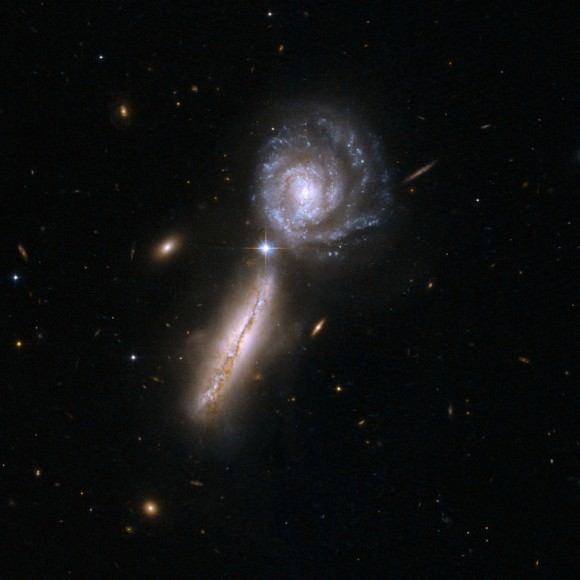
Arp 302 consists of a pair of very gas-rich spiral galaxies in their early stages of interaction. Credit: NASA, ESA, the Hubble Heritage (STScI/AURA)-ESA/Hubble Collaboration, and A. Evans (University of Virginia, Charlottesville/NRAO/Stony Brook University)
A group of astronomers have discovered a vast structure of satellite galaxies and clusters of stars surrounding our Milky Way galaxy, stretching out across a million light years. The team says their findings may signal a “catastrophic failure of the standard cosmological model,” challenging the existence of dark matter. This joins another study released last week, where scientists said they found no evidence for dark matter.
PhD student Marcel Pawlowski and astronomy professor Pavel Kroupa from the University of Bonn in Germany are no strangers to the study – and skepticism — of dark matter. Together the two have a blog called The Dark Matter Crisis, and in a 2009 paper that also studied satellite galaxies, Kroupa declared that perhaps Isaac Newton was wrong. “Although his theory does, in fact, describe the everyday effects of gravity on Earth, things we can see and measure, it is conceivable that we have completely failed to comprehend the actual physics underlying the force of gravity,” he said.
While conventional cosmology models for the origin and evolution of the universe are based on the presence of dark matter, invisible material thought to make up about 23% of the content of the cosmos, this model is backed up by recent observations of the Cosmic Microwave Background that estimate the Universe is made of 4% regular baryonic matter, 73% dark energy and the remaining is dark matter.
But dark matter has never been detected directly, and in the currently accepted model – the Lambda-Cold Dark Matter model – the Milky Way is predicted to have far more satellite galaxies than are actually seen.
Pawlowski, Kroupa and their team say they have found a huge structure of galaxies and star clusters that extends as close as 33,000 light years to as far away as one million light years from the center of the galaxy, existing in right angles to the Millky Way, or in a polar structure both ‘north’ and ‘south’ of the plane of our galaxy.
This could be the ‘lost’ matter everyone has been searching for.
They used a range of sources to try and compile this new view of exactly what surrounds our galaxy, employing twentieth century photographic plates and images from the robotic telescope of the Sloan Deep Sky Survey. Using all these data they assembled a picture that includes bright ‘classical’ satellite galaxies, more recently detected fainter satellites and the younger globular clusters.
Altogether, it forms a huge structure.
“Once we had completed our analysis, a new picture of our cosmic neighbourhood emerged,” said Pawlowski.
The team said that various dark matter models struggle to explain what they have discovered. “In the standard theories, the satellite galaxies would have formed as individual objects before being captured by the Milky Way,” said Kroupa. “As they would have come from many directions, it is next to impossible for them to end up distributed in such a thin plane structure.”
Many astronomers, including astrophysicist Ethan Siegel in his Starts With a Bang blog, say the big picture of dark matter does a good job of explaining the structure of the Universe.
Siegel asks if any studies refuting dark matter “allow us to get away with a Universe without dark matter in explaining large-scale structure, the Lyman-alpha forest, the fluctuations in the cosmic microwave background, or the matter power spectrum of the Universe? The answers, at this point, are no, no, no, and no. Definitively. Which doesn’t mean that dark matter is a definite yes, and that modifying gravity is a definite no. It just means that I know exactly what the relative successes and remaining challenges are for each of these options.”
However, via Twitter today Pawlowski said, “Unfortunately the big picture of dark matter being reportedly fine only helps if looking from far away or with broken glasses.”
One explanation for how this structure formed is that the Milky Way collided with another galaxy in the distant past.
“The other galaxy lost part of its material, material that then formed our Galaxy’s satellite galaxies and the younger globular clusters and the bulge at the galactic centre.” said Pawlowski. “The companions we see today are the debris of this 11 billion year old collision.”
The team wrote in their paper: “If all the satellite galaxies and young halo clusters have been formed in an encounter between the young Milky Way and another gas-rich galaxy about 10-11 Gyr ago, then the Milky Way does not have any luminous dark-matter substructures and the missing satellites problem becomes a catastrophic failure of the standard cosmological model.”
“We were baffled by how well the distributions of the different types of objects agreed with each other,” said Kroupa. “Our model appears to rule out the presence of dark matter in the universe, threatening a central pillar of current cosmological theory. We see this as the beginning of a paradigm shift, one that will ultimately lead us to a new understanding of the universe we inhabit.”
Source: Universe Today
No hay comentarios:
Publicar un comentario